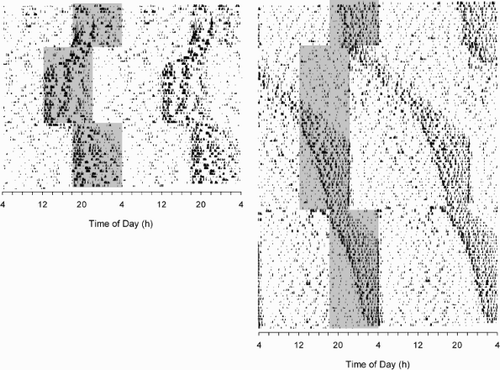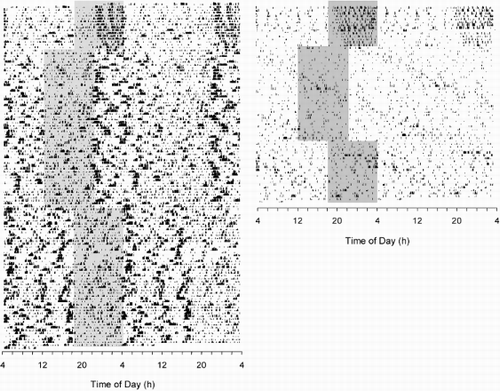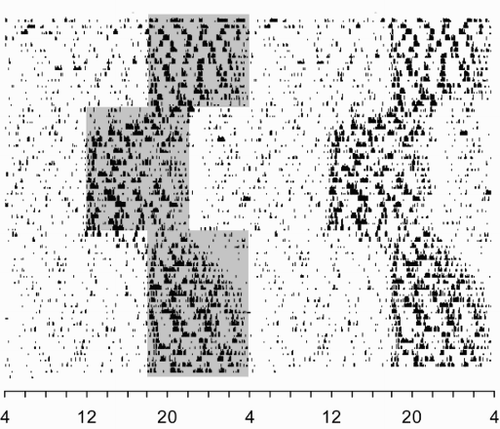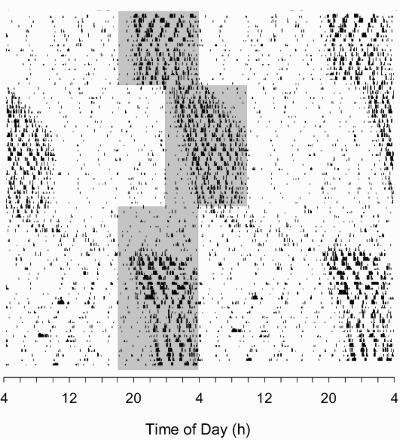There were errors in several figures featured in the article entitled “Re-Entrainment Behavior of Djungarian Hamsters (Phodopus sungorus) with Different Rhythmic Phenotype Following Light-Dark Shifts” by Konrad Schöttner, Antje Limbach, and Dietmar Weinert which appeared in Chronobiology International, Volume 28, Number 1 (2011), pp. 58-69.
, , , , and should have featured shaded areas in the printed article. However, these printed areas did not reproduce correctly and were therefore absent in the final version. The figures are being reprinted below.
FIGURE 1. Changes of the circadian activity rhythm following a single shortening or lengthening of the light time by 6 h. Actograms representative for the majority of WT (left side) and DAO (right side) hamsters are shown. All 12 WT animals resynchronized their activity rhythm to the advanced and the delayed LD zeitgeber. Eight re-entrained by a phase advance following a single shortening of the light time (cf. Table 1), whereas all 12 delayed their activity pattern following a single lengthening of the light time. In contrast, only 8 of 12 DAO hamsters resynchronized to an advanced LD zeitgeber (cf. Figure 3), all by delaying their activity rhythm. Six of these eight hamsters re-entrained following a delay of the LD cycle by delaying their activity rhythm, the other two becoming day-active or free-running. Motor activity is double plotted from top to bottom. Abscissa shows time-of-day in hours. The shaded areas indicate the dark time but were drawn only once for better visualization of the rhythm change following the LD shifts.

FIGURE 2. Changes of the circadian activity rhythm following a single shortening or lengthening of the light time by 6 h. One of the 12 DAO hamsters (cf. Figure 1) became day-active following an advance of the LD cycle (left side). In three other animals, the activity rhythm started to free-run (right side). For further details, see Figure 1.

FIGURE 4. Changes of the circadian activity rhythm of WT hamsters following a single shortening or lengthening of the dark time by 6 h. All 17 animals resynchronized their activity rhythms to the advanced and the delayed LD zeitgeber. For further details, see Figure 1.

FIGURE 5. Changes of the circadian activity rhythm of DAO hamsters following a single shortening or lengthening of the dark time by 6 h. None of six animals resynchronized the activity rhythm to the advanced and delayed LD cycles. One of them became day-active (left panel) and two became arrhythmic (right panel). In three cases, the activity rhythm started to free-run (representative example in middle panel). For further details, see Figure 1.

FIGURE 7. Changes of the circadian activity rhythm of DAO hamsters following a single lengthening or shortening of the dark time by 6 h. All 12 animals resynchronized their activity rhythm following a single lengthening of the dark time by a phase delay. The majority of the animals (n = 8) also re-entrained following a shortening of the dark time by delaying their activity rhythm (cf. Table 1). For further details, see Figure 1.
